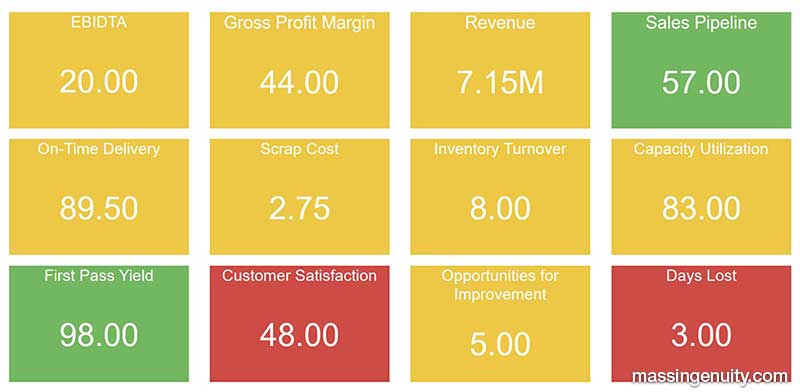Today, data availability is at an extremely high level and most companies are struggling at keeping up with it. The businesses that are succeeding are those that can separate the wheat from the chaff. When it comes to exactly which data is really important, very often companies attempt to keep track of too many data points. On the other hand, some of them regard data and even the analytics which they entail as a “silver bullet” that will solve all their issues. The businesses that achieve success are those that use data as a component of an operating system or performance management system that helps them to regularly track what is important for them. Here, then, are a few trends in data analytics in the manufacturing industry for 2021 and beyond.
Data Domains That Will Help Businesses Succeed
For businesses to be successful, they need to track key data domains including quality, service, cost, and even growth. However, when they lack a balanced approach, they won’t find what they’re looking for or what they thought it would look like.

To this end, to obtain the vast ROI of data, it’s always essential to focus on a balanced approach. Also, it helps to focus on data points which are drivers and lead indicators. Companies will have to focus on process data points that can assist them to determine where their problems lie and can enable them to resolve them.
Lastly, it’s all about which technology they use to display that data and create scorecards that enable them to foster employee engagement within their organizations through transparency. In other words, companies should be asking themselves whether or not they are winning, and if not, what improvements can they make? In terms of data visual management, most businesses want to ensure everything is green in their data points. Nevertheless, some of those data points need to be read in order to help them initiate improvements to their processes to register growth. It can never be green all the time. When an organization’s data points are always green, where will improvements arise from that? A business that has red dots is one that is devoted to lifelong learning and creating continuous improvements. Alternatively, lacking red data points often means the company in question isn’t setting high enough goals.
Successful Businesses Will Foster Employee Engagement

The leadership of many companies think the allure of data analytics is all they need to obtain success. This is, however, not the case. What they truly need to do is reach out to their employees.
Using data that enables them to gain valuable insights on their employees is just as important as gaining insights into cost or even margins. If they fail to engage their workers towards the changes they wish to initiate, leadership won’t be able to see that change happening. So, it’s critical for a business to fully understand where they are coming from to be able to see where they’re headed. Regular data tracking is essential to figure out changes in the marketplace before it becomes too late. It’s not focusing on past metrics, but understanding past metrics to see if you’re losing your market share and efficiently responding to market changes as was witnessed with the COVID-19 pandemic.
It’s also about transparency with employees and ensuring you equip high performers to help their team members who are struggling. Leadership must emphasize the importance of a company’s vision through high-level metrics to their employees. This way, the whole organization will understand the impact of such metrics and align their efforts to them.
Manufacturers Will Have To Have A Customer-First Culture
Very often businesses think they have to abandon what they have been doing to align themselves to an effective data strategy. This shouldn’t be so. Data should only be viewed as an implementation of a digital transformation that can augment their day-to-day core operations. Granted, there is so much data available that hinders companies to streamline their decision-making process. The trick lies in understanding data that enables them to create value for their clients, and not simply help them in extracting value for themselves like cost reduction and process or productivity improvements. It’s about understanding the customer’s position to be able to scale and grow, whether it’s in newer markets or regions.
Manufacturers Will Have To Understand And Use Their Key Outcome Metrics

Companies can achieve great success when they use data better by understanding the key outcome metrics they need to shoot for and then align them with their strategic key metrics.
Additionally, they shouldn’t regard data as a sort of panacea and abandon everything else. What they need to do is review what’s worked well over, say, the last 30 days and predict what they should do in the next 30 days. Businesses have to learn to consume data they already have to enable them to make better and quicker decisions in the future. In turn, this will furnish them with a competitive edge by making improvements quicker than their competition. You’ve got to harness the power of data to create more value for customers.
Obstacles Manufacturers Will Face In Implementing A Data-Driven Culture
In the first place, the term digital transformation for some organizations is merely a cliche and for many companies, there isn’t any transformation that has taken place. Transformation necessitates a behavioral change, and that is never easy. Businesses need to prepare themselves for resistance to establish a data-driven culture. On the flip side, staying focused on key outcome metrics and understanding how to use data and align it with process metrics is also another significant obstacle for manufacturers. When companies determine how well their processes are improving and how behavior is changing at an organization-wide level is an essential success. Finally, it’s about having a scorecard to precisely measure whether you are winning or not, and making the necessary changes whenever necessary.
Data Analytics Will Augment Leadership Decisions

You may automate almost everything in your business, but it can never replace good leadership. Good leadership is necessary to cast vision, hold people accountable, and determine whether metrics are driving the desired actions and driving success in an organization.

Founder and CEO – Growing Champions, LLC

